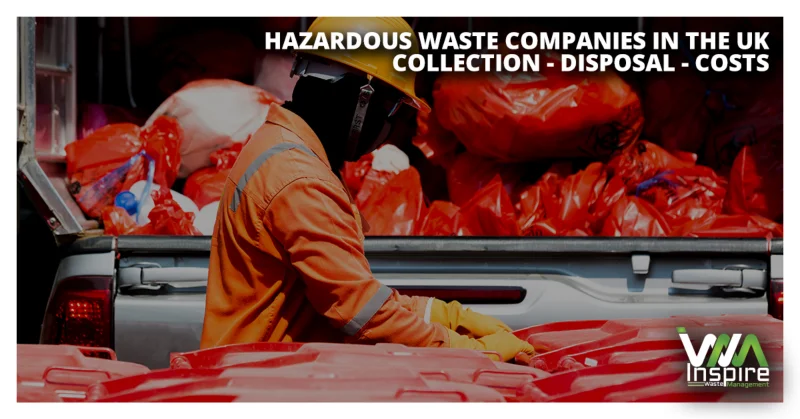
Hazardous wastes pose a greater risk to the environment and human health than non-hazardous waste and thus require a stricter control regime. We’ve put together the following article to help you understand everything your business needs to know about the hazardous waste treatment and how to deal with it.
Let’s get right to it.
What defines hazardous waste
Hazardous waste is a broader term that also encompasses items that fall into terms such as toxic waste or dangerous goods. However, to be more specific, dangerous goods, abbreviated DG, are substances that when transported are a risk to health, safety, property or the environment. Certain dangerous goods that pose risks even when not being transported are known as hazardous materials (syllabically abbreviated as HAZMAT or hazmat).
In any case, hazardous waste is a waste that has substantial or potential threats to public health or the environment. Characteristic hazardous wastes are materials that are known or tested to exhibit one or more of the following hazardous traits:
- Ignitability
- Reactivity
- Corrosivity
- Toxicity
Hazardous waste examples mentioned below are all materials specifically listed by environmental consultancy companies and regulatory authorities as hazardous wastes which are from non-specific sources, specific sources, or discarded chemical products.
Hazardous wastes may be found in different physical states such as gaseous, liquids, or solids. Hazardous waste is a special type of household or business waste because it cannot be disposed of by common means like other by-products of our everyday lives. Depending on the physical state of the waste, treatment facility and solidification processes might be required.
Hazardous waste collection for businesses
Get a quote
What are the major categories of hazardous waste?
Hazardous materials (also applicable to dangerous goods) are divided into nine classes and further specified in several subcategories (where applicable). The basis of the hazardous waste categories is specific chemical characteristics producing the risk.
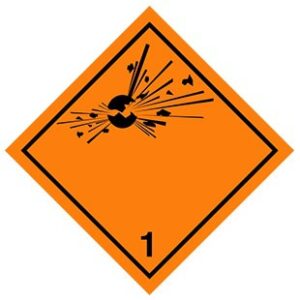
HAZMAT Class 1 Explosive materials
HAZMAT Class 1: Explosive materials
Class 1 hazardous items cover substances that pose the risk of an explosion, including explosions that may project fragments and firebrands, as well as more general fire hazards and even fireworks. Class 1 hazardous substances are not usually shipped by air and are further divided into 6 subdivisions.
Examples: Fireworks, Type E water emulsion blasting agents, bulk industrial explosives (ANFO – Ammonium Nitrate/Fuel Oil), Lithium-Ion batteries

HAZMAT Class 2 Hazardous Gases
HAZMAT Class 2: Hazardous Gases
The hazardous gases category is divided into three subdivisions that include flammable gases, toxic gases and gases that are neither flammable nor toxic but still pose a serious risk to health such as high concentrations of helium and oxygen.
Examples: Aerosols and gas-pressured cans that are Flammable (also called combustible), Non-Flammable/Non-Poisonous, as well as Poisonous (toxic)

HAZMAT Class 3 Flammable Liquids
HAZMAT Class 3: Flammable Liquids
Class 3 hazardous waste is used, most often, for mixtures of liquids that release flammable vapours at relatively lower temperatures and have a flashpoint below 60.5 degrees Celsius (140.9 degrees Fahrenheit).
Examples: Solvents and thinners, Combustible Liquids including gasoline and fuel oils

HAZMAT Class 4 Flammable Solids
HAZMAT Class 4: Flammable Solids
Flammable solids are further divided into 3 subdivisions that include highly flammable solid materials, solids with a propensity for spontaneous incineration and substances that emit flammable gases when in contact with water (water-reactive).
Examples: hardened solvent based paint but also nitrocellulose and magnesium, aluminium alkyls and white phosphorus, sodium, calcium, potassium and calcium carbide
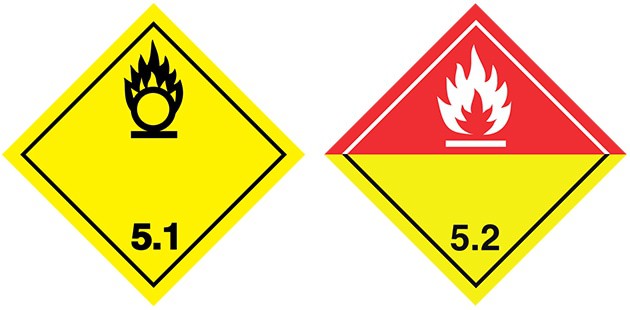
HAZMAT Class 5 Oxidising Substances and Organic Pesticides
HAZMAT Class 5: Oxidising Substances and Organic Pesticides
This class is divided into two subdivisions and covers agents – Oxidiser and Organic Peroxides – that react with oxygen (as well as organic pesticides) and can cause or enhance the combustion of other materials.
Examples: hydrogen peroxide, potassium permanganate, sodium nitrite, ammonium nitrate fertilisers and oxygen generators

HAZMAT Class 6 Toxic and Infectious Substances
HAZMAT Class 6: Toxic and Infectious Substances
Class 6 is divided into two subdivisions: poisonous materials and biohazards. In general Class 6 are all materials (except for hazardous gases classed 2) known to be so toxic to humans that it presents a health hazard during transportation.
Examples: medical and biomedical waste, clinical waste, biological cultures, samples and specimens; also, tear gas substances and dyes
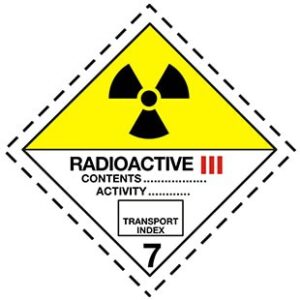
HAZMAT Class 7 Radioactive materials
HAZMAT Class 7: Radioactive Materials
Class 7 hazardous waste covers any materials containing radionuclides where both the activity concentration and the total activity in the consignment exceed the values specified in the ONR (Office for Nuclear Regulation) protocols.
In general, all Class 7 radioactive materials will have a specific activity greater than 70 becquerels per kilogram.
Examples: radioactive ores, medical isotopes, yellowcake, density gauges, mixed fission products, surface contaminated objects
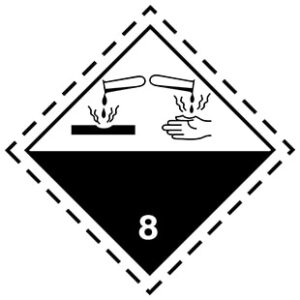
HAZMAT-Class-8-Corrosive-materials
HAZMAT Class 8: Corrosive Materials
Class 8 hazardous waste involves corrosive liquids and solids that will cause severe damage when in contact with human tissue. Corrosive materials also include liquids prone to cause any physical damage and destruction to the environment in the case of leakage.
Examples: Corrosive items include battery acids, sulfuric acid, mercury and ammonia
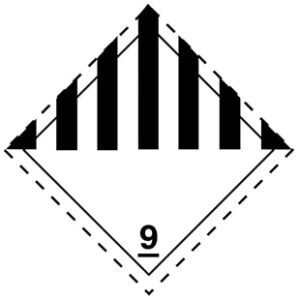
HAZMAT-Class-9-Miscellaneous
HAZMAT Class 9: Miscellaneous
Class 9 is for all dangerous items that do not fit one of the definitions listed in Class 1 through Class 8. These include substances that may pose a hazard during transportation. A new sub-class, class 9A, has been in effect since January 1, 2017. This is limited to the labelling of the transport of lithium batteries.
Examples: Class 9 most often includes items with anaesthetic properties, solid dry ice, asbestos, life rafts and chain saws, most cleaning products such as bleach, detergents and vehicle washing agents.
Looking for hazardous waste management?
Get a quote
The difference between hazardous and non-hazardous waste
All waste – household waste included – is regulated but different actions are required depending on the type and material. As a responsible citizen or a business owner, it is important to be able to define the difference between these two types of wastes to ensure storage and disposal requirements are met and undue damage is not done to other people or the environment (e.g. battery disposal, or electrical equipment scrapping).
The classification into hazardous and non-hazardous waste is based on the system for the classification and labelling of dangerous substances and materials, which ensures the consistency of applying safety protocols over the whole life cycle of products and goods. Waste generators that are hazardous pose a greater risk to the environment and human health than non-hazardous waste and thus require a stricter control regime, specific waste containers, packaging compliance and carefully thought out waste disposal processes (ec.europa.eu).
Problems with hazardous waste disposal
Disposal of hazardous waste
Historically, some hazardous wastes were mostly a producer responsibility and disposed of in regular landfills. Increased need for industrial cleaning and commercial waste generation resulted in unfavourable amounts of hazardous materials seeping into the ground. The chemical waste eventually entered to natural hydrologic systems and became an environmental responsibility. Many landfills, whether it deals with plastic recycling, electrical equipment and battery disposal (WEEE recycling) or even food waste now require countermeasures against groundwater contamination. For example, a barrier has to be installed along the foundation of the landfill to contain the hazardous chemical substances (or radioactive waste) that may remain in the disposed waste.
Currently, volume hazardous waste must often be stabilised (especially in the case of radioactive waste management) and solidified in order to enter a landfill. Companies that generate toxic waste hire companies like Inspire Waste Management to help with hazardous waste disposal (e.g. temperature incineration) in order to stabilise and dispose of them, or recycle and reuse them. Since many onsite waste materials could be put into use again, and reduce environmental impact. For example, most flammable materials can be recycled into industrial fuel. Some materials with hazardous constituents can be recycled, such as lead-acid batteries.
Source: en.wikipedia.org
Get a quote
How Do You Dispose Of Hazardous Waste?
Fortunately, it is possible to recycle many hazardous materials to reduce the amount of onsite waste that ends up in landfills. According to experts, the following hazardous items can be recycled: “Fluorescent tube and light bulbs, glues and adhesives, cleaning fluids, oil-based paints, garden chemicals, batteries, propane and butane tanks, and automobile fluids such as engine oil or brake fluid.” Many recycling centres accept certain types of hazardous waste, so if you have a commercial waste stream generating specific waste (like sharps waste or clinical waste) make sure to contact Inspire Waste as we partner with the majority of local recycling facilities across the United Kingdom.
Hazardous Waste Spill
Emergency spill response occurs during a hazardous substance spillage that is greater than 1 litre, involving a toxic or reactive compound, presenting a fire or environmental hazard, or requiring additional PPE (Personal Protective Equipment – e.g. a respirator), a presence of a mobile chemist and specialised training to properly clean up.
If you’re in the risk of having a hazardous waste spill or chemical emergency please reach out to discuss the issue as the chemical spill can only be properly cleaned by trained personnel (a mobile chemist) using appropriate waste containers, ensuring packaging compliance and applying PPE (e.g. respirator, chemical-resistant suit, hazmat suit) (riskmanagement.nd.edu)
Hazardous Pharmaceutical Waste Disposal
Pharmaceutical Waste Solutions
Pharmaceutical waste is any waste which contains medicinal drugs that are expired, unused, contaminated, damaged or no longer needed, such as sharps waste, chemical waste and biohazards.
We collect and dispose of all pharmaceutical waste type materials containing outdated pharmaceuticals and recalled pharmaceutical stock, chemical kits for controlled drugs destruction, or even cytostatic and cytotoxic waste.
If pharmaceutical waste is not stored and disposed of correctly in a treatment facility, it can generate hazardous waste and prove to be extremely harmful to the environment along with human and animal health.
Contact the experts today on 0800 211 8390 we collect all types of pharmaceutical waste from all locations in the UK.
Hazardous Waste in the Construction Industry
Disposing of Your Construction Waste
If you determine that certain materials cannot be reduced or reused, then your remaining options are to recycle (e.g. solvent recycling) or dispose of them. The most practical and effective construction waste disposal method is a skip hire from a waste removal company such as Inspire Waste Management. You should ensure that you focus on a volume hazardous waste collection and hire the necessary number of skips to separate recycling and waste, as well as hazardous and non-hazardous waste.
You also need to create a classification description and waste transfer notes before you send off waste for recycling or disposal.
As a rule of thumb, the waste management hierarchy is as follows:
- Reduce
- Reuse
- Recycle
- Dispose
Taking proactive steps is the best way to meet the hierarchy: facilities manag. or a designated person should carry out a site waste management audit to determine what amount of business waste you generate and how; whether you need emergency spill response procedures in place, and what type of hazardous waste treatment is the requirement.
Typical materials and waste streams from construction sites that fall within the Hazardous Waste Regulations and needs specialised industrial cleaning crew include:
- Asbestos
- Treated wood, glass, plastic (alone or in mixtures) containing dangerous substances
- Bituminous mixtures containing coal tar and tar products
- Metals containing dangerous substances
- Cables containing oil, coal tar and other dangerous substances
- Rubble or hardcore containing dangerous substances
- Soil, stones and dredging spoil containing dangerous substances
- Gypsum materials such as plasterboard containing hazardous materials
- Un-used or un-set cement
- Paints and varnishes containing organic solvents or other dangerous substances
- Paint or varnish remover
- Adhesives and sealants containing organic solvents or other dangerous substances
- Empty packaging contaminated with residues of dangerous substances – e.g. paint cans, intermediate bulk containers (IBCs) and drums
To help you dispose of waste suitably and safely on construction, demolition, or excavation site, contact us and we will provide you with an overview of how to follow a correct industrial cleaning process and hazardous waste costs involved.
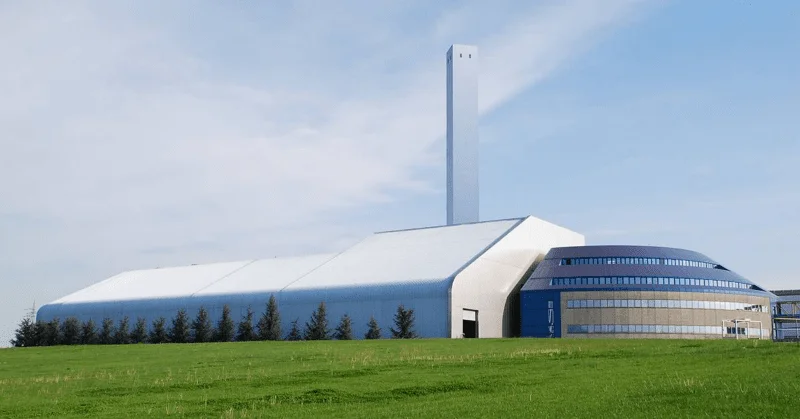
Hazardous waste incineration – a quick note
Incineration of hazardous waste is one of the most efficient methods of many types of waste management. No other form of hazardous waste disposal has matched its efficiency at volume reduction, and the permanent destruction of organic wastes.
That convenience may come at a price, as questions and concerns continue to surround the potential human health impacts, environmental responsibility and ecosystem effects caused by temperature incineration (routledge.com).
Incineration and other high-temperature waste treatment systems are described as “thermal treatment” or “temperature incineration”. Incinerators reduce the solid mass of the original waste by 80%-85% and the volume (already compressed somewhat in garbage trucks) by 95%-96%, depending on composition and degree of recovery of materials such as metals from the ash for recycling.
This means that while incineration does not completely replace landfilling, it significantly reduces the necessary volume for disposal (en.wikipedia.org).
As a fully compliant waste incineration service provider, we can provide free waste assessments and audits to understand your precise needs – whether it is plastic recycling, food waste, confidential waste or more broadly hazardous waste management.
Hazardous Waste Companies – What Should You Expect?
Hazardous waste collection, recycling and disposal
Using Inspire Waste Management hazardous waste collection, recycling and disposal service means that you and your business are fully compliant with all relevant and applicable hazardous waste regulations. Giving you peace of mind that all your hazardous waste is being disposed of correctly, safely and legally.
Our Newcastle Hazardous Waste Company technical team is staffed by fully qualified specialists (e.g. mobile chemists), who are knowledgeable and experienced in the classification, handling, management and disposal of most types of hazardous waste. We are always up-to-date with the latest British and European legislation and can provide advice on your legal requirements for all waste types. This will not only ensure legal Government compliance for the collection, treatment and disposal of your hazardous wastes, but also environmental consultancy.
Inspire Waste Management collections are fully compliant and certified CarbonNeutral®. The certification is awarded by Natural Capital Partners and means that each time one of our waste vehicles collects business waste from you, the journey doesn’t impact on your carbon footprint.
We operate our own fleet of dedicated specialist collection vehicles and ADR (Carriage of Dangerous Goods Certified) trained drivers, in addition to our industry leading waste transfer stations, as well as treatment and disposal facilities.
Call us now and our expert nationwide waste collection team will guide you through the complexities of hazardous waste management.
Hazardous Waste Disposal Cost
If the organisation you work for regularly creates harmful waste, a recurring waste management solution is essential in dealing with the waste effectively and keeping the costs down. However, for a one-off disposal service, the cost will be based on how much waste fills the removal truck. Therefore, the average hazardous waste disposal cost is between £300 (for ¼ of truckload) to £1000 (for a full truckload). However, contractors may also charge on a per ton basis and on average, the commercial hazardous waste disposal cost will range between £40 – £600 per ton.
Inevitably, a number of factors will influence the quote given to remove the hazardous waste from your property.
This includes:
- The volume of waste;
- How dangerous it is;
- Where the waste is located.
Prices will naturally always be a key driver for small businesses. Call 0800 002 9282 to connect with Inspire Waste professionals who can provide a quote and safely remove the harmful waste from your premises.
Top tip: If your site requires a regular hazardous waste collection, seek quotes for ongoing waste management solutions, as these will likely be cheaper than one-off pricing.





